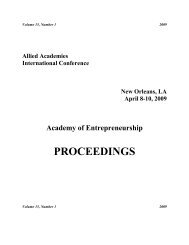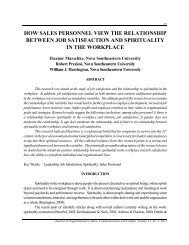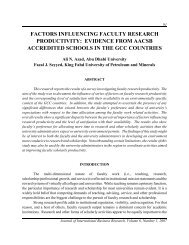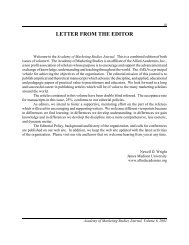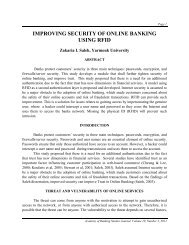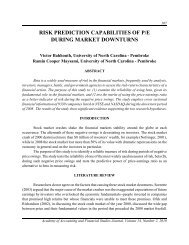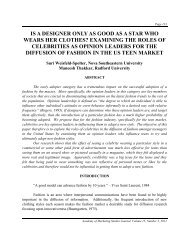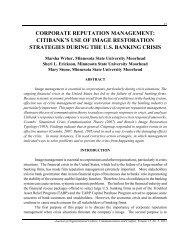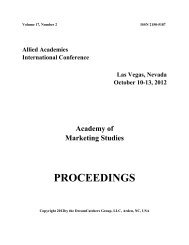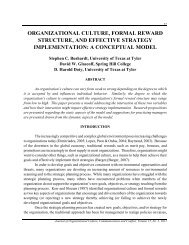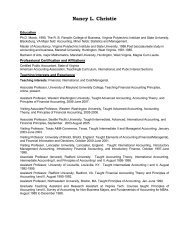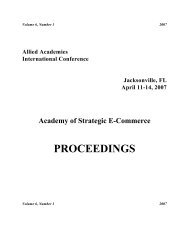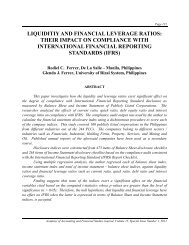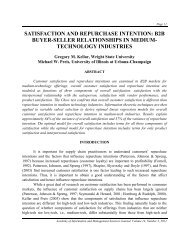AOCCC - Allied Academies
AOCCC - Allied Academies
AOCCC - Allied Academies
Create successful ePaper yourself
Turn your PDF publications into a flip-book with our unique Google optimized e-Paper software.
page 34<br />
<strong>Allied</strong> <strong>Academies</strong> International Conference<br />
boundaries are imposed that influence the uses and interactions with the objects they value.<br />
They seek to ensure control and ownership of the objects they value by protecting themselves<br />
against loss and seek to enlarge their territories and increase the value of these objects within the<br />
boundaries which will enhance their self image (Hall, 1996). This process continues into<br />
adulthood as the attachment, ownership, and boundaries become increasingly complex and more<br />
dynamic.<br />
TERRITORIAL COMPLEXITY<br />
As human territory develops it becomes more complex (Pierce, et. al., 2003, p. 103).<br />
Territories of an individual overlap and become shared with others. They become multidimensional<br />
occurring at both horizontal and vertical levels within organizations, and exist<br />
across multiple systems.<br />
Some of the objects a child develops attachments to must be shared with others. This is<br />
especially true in families that have siblings giving rise to sibling rivalry and rules to resolve the<br />
conflict. The shared or overlapping territories creates an interaction that includes<br />
interdependence, assimilation, and adjustment. For instance, rooms and toys can be shared.<br />
Rules, norms and procedures can be created as to who can use them, how they are to be used,<br />
and when they are to be used. The same thing happens in an office where common areas such as<br />
break rooms and equipment are shared. It can happen between individuals or groups of<br />
individuals where community property is shared such as roads and recreational facilities.<br />
Human territories are multi-dimensional and hierarchical. Territories exist horizontally<br />
where a child has his or her own clothes, toys, room or chores within a family structure. At<br />
school a child can have his or her own desk and a certain place in the lunch line. Individuals can<br />
own property or have their own ideas. At work a person can have their own parking space, desk<br />
and responsibilities. Territories also exist vertically across and between levels in the social<br />
structure of families or the hierarchical structure of a formal organization where territories such<br />
as formal work groups span vertical boundaries (Desrocher, L. & Sargent, L., 2003). Or, they<br />
can be a combination of both horizontal and vertical territories where interaction and sharing is<br />
required.<br />
Human territories also exist in systems. The family unit is a social system just as schools,<br />
businesses, or communities are social systems. There will be multi dimensional and overlapping<br />
territories within and between the systems adding to the complexity of boundaries which<br />
determine how territories are managed (Desrocher, L. & Sargent, L., 2003). As a result an<br />
individual can belong to and share numerous territories with different and sometimes conflicting<br />
boundaries.<br />
For instance children, from different families or cultures can have a different set of rules<br />
for sharing a toy at home and have yet a different set of rules for sharing the same toy at school.<br />
Or a person from one department can have a norm, policy, procedure or rule for using a copier or<br />
cleaning up a common area that differs from another department, an informal group, or from<br />
what is expected by the boss. These rules can be quite clear or vague and imprecise. To<br />
complicate matters further, the rules can change over time.<br />
Orlando, 2011<br />
Proceedings of the Academy of Organizational Culture, Communications and Conflict, V.16(1)



